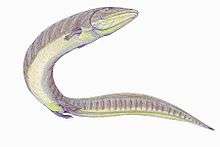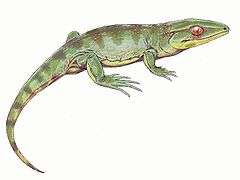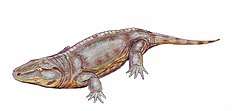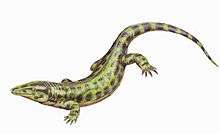Orobates
Orobates is an extinct genus of diadectid. It lived in the middle Permian, about 260 million years ago. Its remains were found in Germany.[1] A combination of primitive and derived traits (i.e. autapomorphic and plesiomorphic) distinguish it from all other well-known members of the Diadectidae, a family of herbivorous reptile-like amphibians. It weighed about 4 kg and appears to have been part of an upland fauna, browsing on high fibre plants.[1][2]
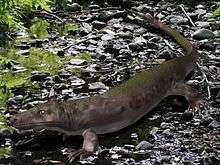
| Orobates | |
|---|---|
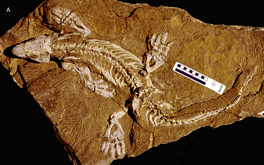 | |
| Holotype specimen | |
| Scientific classification | |
| Kingdom: | Animalia |
| Phylum: | Chordata |
| Order: | †Diadectomorpha |
| Family: | †Diadectidae |
| Genus: | †Orobates Berman et al., 2004 |
| Type species | |
| Orobates pabsti Berman et al., 2004 | |
Locomotion

The trace fossil species Ichniotherium sphaerodactylum, from Bromacker in Germany, has been attributed to Orobates.[3] A study in 2015 found that the genus was characterized by a long body and tail, with fairly short legs and a short skull compared to the more derived Diadectes. This indicates Orobates was less specialised for long treks compared to Diadectes. A three-dimensional digital reconstruction of the holotype specimen allowed further analysis of the postcranium.[2] An analysis of the mobility of the hip joint of the reconstructed holotype indicated that its limb function was similar to that of modern salamanders.[2]
A detailed multidisciplinary study published in 2019 found that Orobates moved more like modern caimans than salamanders. The study began with the digitization of its holotype specimen using CT scanning to figure out the range of motion of its joints. A digital model of its fossil trackways helped narrow down the possibilities. The researchers also studied the locomotion of four extant sprawling tetrapods using X-ray motion analysis. The extant tetrapods chosen for the study were axolotls, blue-tongued skinks, green iguanas, and spectacled caimans.[4]
The biomechanical data of the locomotion of the extant tetrapods and the digital models of Orobates' holotype and fossilized trackways were then used to create a dynamic simulation. It allowed the researchers to account for physical factors like gravity, friction, and balance. The simulation was then validated under real-world conditions with a life-sized robot called OroBOT. The researchers tested 512 different gaits and found that Orobates moved most like a caiman. It had a relatively erect posture and walked with a slight side-to-side motion.[4][5][6]
References
- Berman, D. Berman, D. S, Henrici, AC, Kissel, R., Sumida, SS, and Martens, T. S, Henrici, AC, Kissel, R., Sumida, SS, and Martens, T. (2004): A new diadectid (Diadectomorpha), Orobates pabsti, from the Early Permian of Central Germany. Bulletin of the Carnegie Museum of Natural History No 35: pp 1-37. abstract
- Nyakatura, John A.; Allen, Vivian R.; Lauströer, Jonas; Andikfar, Amir; Danczak, Marek; Ullrich, Hans-Jürgen; Hufenbach, Werner; Martens, Thomas; Fischer, Martin S. (10 September 2015). "A Three-Dimensional Skeletal Reconstruction of the Stem Amniote Orobates pabsti (Diadectidae): Analyses of Body Mass, Centre of Mass Position, and Joint Mobility". PLOS ONE. 10 (9): e0137284. doi:10.1371/journal.pone.0137284. PMC 4565719. PMID 26355297.
- Voigt, S.; Berman, D.S.; Henrici, A.C. (September 2007). "First well-established track-trackmaker association of Paleozoic tetrapods based on Ichniotherium trackways and diadectid skeletons from the Lower Permian of Germany". Journal of Vertebrate Paleontology. 27 (3): 553–570. doi:10.1671/0272-4634(2007)27[553:FWTAOP]2.0.CO;2.
- A. Nyakatura, John; Melo, Kamilo; Horvat, Tomislav; Karakasiliotis, Kostas; R. Allen, Vivian; Andikfar, Amir; Andrada, Emanuel; Arnold, Patrick; Lauströer, Jonas; R. Hutchinson, John; S. Fischer, Martin; J. Ijspeert, Auke (16 January 2019). "Reverse-engineering the locomotion of a stem amniote". Nature. 565 (7739): 351–355. doi:10.1038/s41586-018-0851-2. eISSN 1476-4687. PMID 30651613.
- Baker, Noah (16 January 2019). "Watch: Robot reveals how ancient reptile ancestor moved". Nature. doi:10.1038/d41586-019-00186-x. PMID 30657749. Retrieved 18 January 2019.
- Wong, Kate (17 January 2019). "RoboFossil Reveals Locomotion of Beast from Deep Time". Scientific American. Retrieved 18 January 2019.
